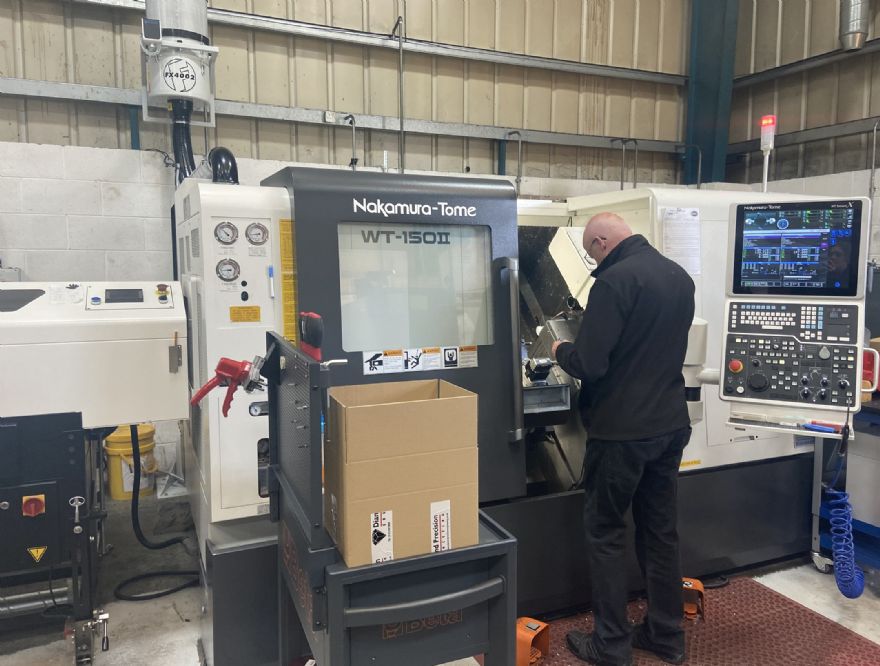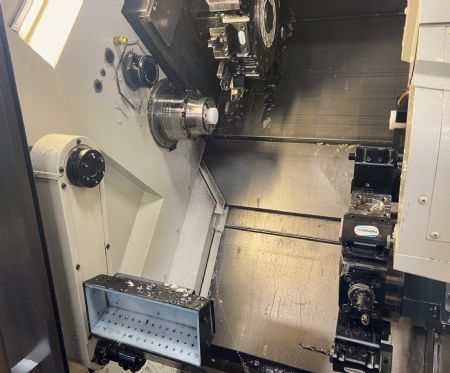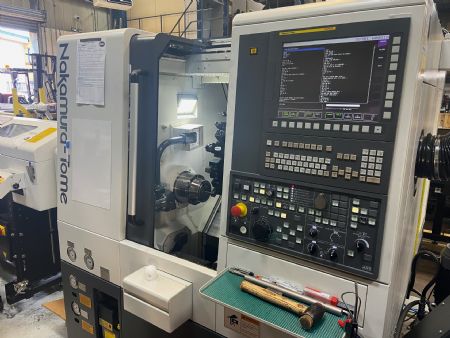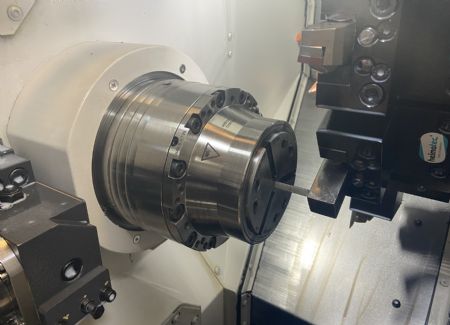 The Nakamura WT150II in-situ at Diamond Precision
The Nakamura WT150II in-situ at Diamond PrecisionLocated across three sites on the Wirral,
Diamond Precision Engineering (DPE) has evolved from a small toolmaking business founded in 1986 into a prominent sub-contract manufacturing specialist. From a company producing press tools and fixtures in its infancy, DPE now offers a wide range of services including 3-D printing, laser cutting and CNC folding, fabrication and CNC machining. As a business that always invests in high-end technology to boost its capabilities, the sub-contractor has recently installed two Nakamura-Tome turning centres — a WT150 and an AS200 — supplied by the Wellesbourne-based
Engineering Technology Group (ETG).
Company director Harry Pitt said: “The business was started by my father and it has been built up from there. It started out as a toolmakers, evolving into a CNC machine shop and later incorporating laser cutting and fabrication — the business now spans across three sites. My brother and I have always been very much involved. We were inspired into a career in manufacturing — my brother now runs the laser cutting and fabrication side and I manage the machining division. It is here that we have just installed the new Nakamura machines from ETG.”
 Pictured right: The spacious work area of the twin-spindle twin-turret Nakamura WT150II at Diamond Precision
Pictured right: The spacious work area of the twin-spindle twin-turret Nakamura WT150II at Diamond PrecisionHe continued: “My Dad loves an auction, so down the years we have had lots of auction buys where some have gone well, and some haven’t. We have found that a new machine can be cheaper than an older machine due to the maintenance costs of old machines which may prove troublesome. When we bought a new laser machine recently, the payments worked out less than the maintenance costs of an older alternative.
“We had some ageing lathes that had reliability issues, making the planning of jobs against the machines an issue. Support and getting people to repair the machines was also a problem. Considering all this, we wanted to buy a new machine that we could rely on and trust - and just get parts through the door faster. For us to be competitive, we have to continually produce parts faster and better.”
Referencing the benefit of the Nakamura WT150II from ETG, Harry continued: “We had a job that I quoted on and we were three-times more expensive than the customer expected – and I really wanted us to land the job. There were obviously people already doing the job at the lower price point, so I wanted to know how we could compete. Now, we have the WT150II machine, we have won the order by easily undercutting the customer’s price point. We are now producing 4,000 parts as part of the ongoing order, which proves that the impressive speed and productivity of the Nakamura technology can make us more than just competitive but also industry-leading.”
New machining methodologiesSince investing in the Nakamura WT150II and AS200, DPE has adopted new machining methodologies to manufacture existing parts differently, using the full capability of the machines from ETG. Harry continued: “For my Dad, brother and I – investing in our business to innovate is our passion. Finding faster ways to make parts and be more efficient is a really rewarding and satisfying pastime. What we are trying to do is eliminate parts coming off turning centres and then going for secondary milling operations. We will always look for the most efficient way to manufacture parts.”
 Pictured left: The Nakamura AS200 is a compact powerhouse that offers exceptional flexibility for Diamond Precision
Pictured left: The Nakamura AS200 is a compact powerhouse that offers exceptional flexibility for Diamond PrecisionAlluding to one example, Harry said: “We are parting-off with slitting disks to minimise material usage - we want to try every little thing to improve our processes. As a company that is always trying new ideas, we have previously been limited by the capabilities of the machine – the Nakamuras have so far never let us down. Whatever we want to try, we can do.”
Looking specifically at the Nakamura AS200 where DPE is machining a small job from a square bar that would have originally been processed on a machining centre, Harry said: “The small job was previously manufactured on a machining centre and it was a horribly tricky job to handle. The 316 stainless steel part had three operations until one of our team suggested bar feeding the job on a Nakamura. Now, the AS200 is producing a better-quality part and as it is bar-fed, meaning that it can run automated all day.
“Equally as important, it is producing a better quality part and more consistent surface finish as it is even deburred in-cycle. Now, we have drastically reduced the cycle time and we don’t need an operator present. As a small business, we have to innovate or our competitors will overtake us. Fortunately, we are really lucky that we have some great guys with fantastic and creative manufacturing ideas in our business.”
Two finished parts in one hitAdding his thoughts on the Nakamura AS200, Harry added: “Even though our AS200 is not a twin-spindle and twin-turret variant, it has thoroughly impressed us. There are lots of jobs the single-spindle and single-turret configuration can handle in just one operation. One job is a family of two parts and because of the programming expertise of our guys, we can profile the first and second parts in one hit and then just part them off. This is giving us two finished parts in one hit.
 Pictured right: Small prismatic parts machined in one-hit from square section bar on the Nakamura AS200 instead of undergoing multiple set-ups on a machining centre
Pictured right: Small prismatic parts machined in one-hit from square section bar on the Nakamura AS200 instead of undergoing multiple set-ups on a machining centre“We have one job that we used to laser cut, prep it on a turning centre and then do a final turning operation before we put it in a special machine to cut teeth in the part. Now, we put it straight on the AS200 and it is done in a single operation by taking on all of the turning operations and machining the teeth. It is not doing conventional turning or milling, but it is being used like a form cutting machine.”
With both the larger Nakamura WT150II and the smaller Nakamura AS200 machines having part catchers, live tooling, and bar feeders - the combination already offers an exceptional level of automation. Harry explained: “We have found that automation is like an art form in itself. Making the parts when we are here is half the battle but what we have learned with Nakamura is the ability to leave the machines to run unattended overnight. However, automation brings other challenges like getting the parts out of the machine. If we are making a batch of 700 parts in one night, how do we get parts out of the machine?
“The WT150II has a conveyor that simplifies this, but it can be more challenging on a smaller machine – it is just a learning process. On the WT150II, we had some parts that we left running and the swarf was too long and stringy, jamming the conveyor and stopping the machine. It provided another opportunity to learn, we have now employed strategies to break the swarf. It may have added 3sec to a cycle, but we recently left the machine to run from Friday morning through to Saturday night.”
Harry concluded: “The one thing that has particularly impressed me is how well the Nakamura machines hold workpiece dimensions, tolerances and the surface finishes. Leaving your machines to run unmanned all of the time is like a ‘mythical art form’. We are still very much learning the intricacies of tool, swarf and material management – but with Nakamura, we know that what was once impossible for our business is now achievable.”